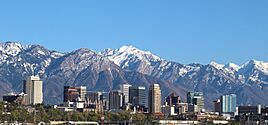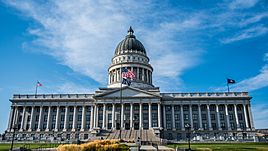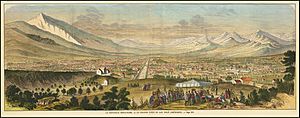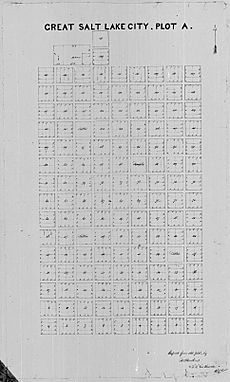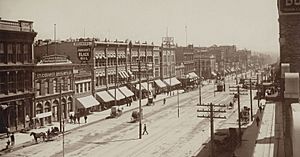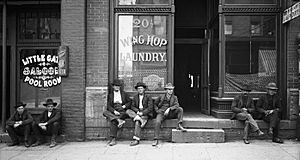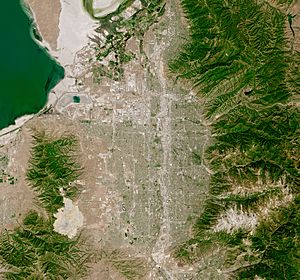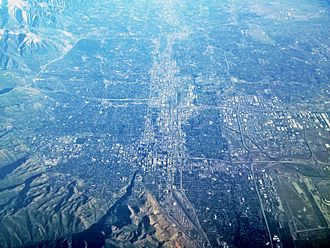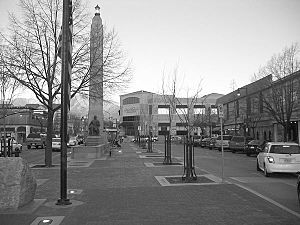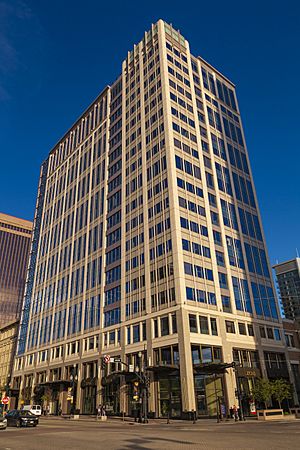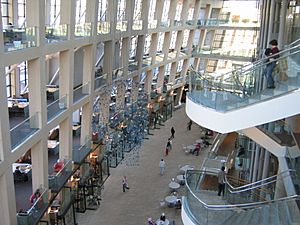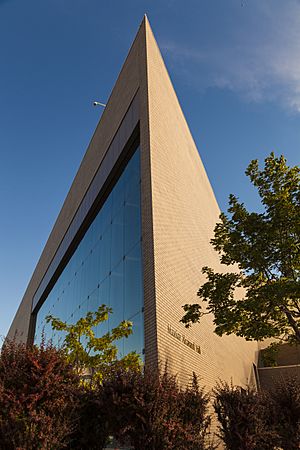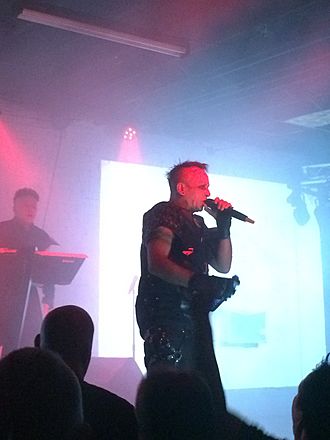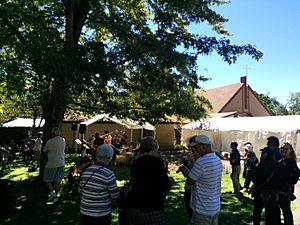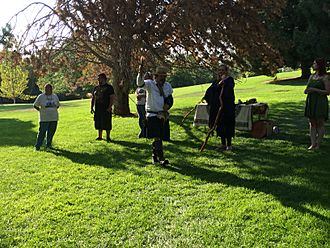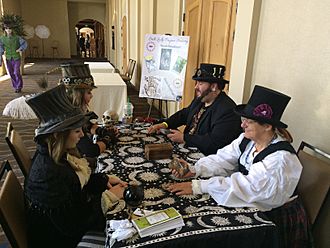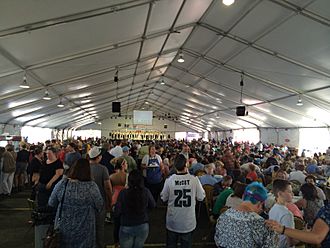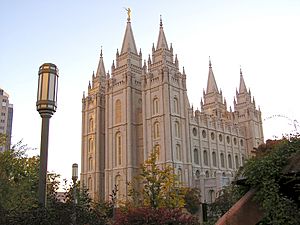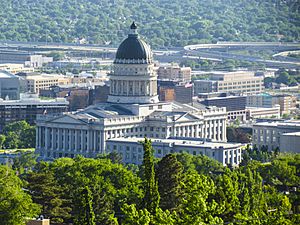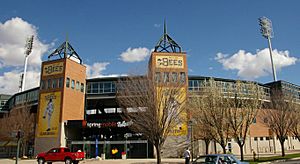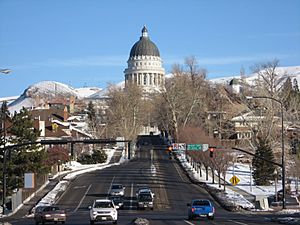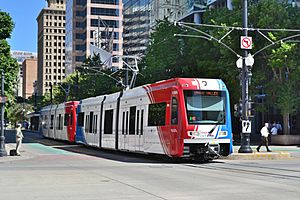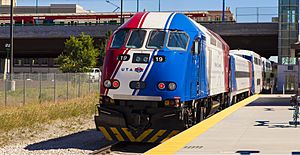Salt Lake City facts for kids
Quick facts for kids
Salt Lake City
|
|||
|---|---|---|---|
| City of Salt Lake City | |||
|
Skyline of Downtown Salt Lake City
TRAX light rail system
|
|||
|
|||
| Nickname(s):
"The Crossroads of the West"
|
|||
| Country | |||
| State | |||
| County | Salt Lake | ||
| Platted | 1857 | ||
| Named for | Great Salt Lake | ||
| Government | |||
| • Type | Strong Mayor–council | ||
| Area | |||
| • City | 110.81 sq mi (286.99 km2) | ||
| • Land | 110.34 sq mi (285.77 km2) | ||
| • Water | 0.47 sq mi (1.22 km2) | ||
| Elevation | 4,265 ft (1,300 m) | ||
| Population
(2020)
|
|||
| • City | 200,133 | ||
| • Estimate
(2023)
|
209,593 | ||
| • Rank | 117th in the United States 1st in Utah |
||
| • Density | 1,797.52/sq mi (701.84/km2) | ||
| • Urban | 1,178,533 (US: 41st) | ||
| • Urban density | 3,923.0/sq mi (1,514.7/km2) | ||
| • Metro | 1,257,936 (US: 47th) | ||
| • CSA | 2,746,164 (US: 22nd) | ||
| Demonym(s) | Salt Laker | ||
| GDP | |||
| • Metro | $135.409 billion (2022) | ||
| • CSA | $215.338 billion (2022) | ||
| Time zone | UTC−7 (Mountain) | ||
| • Summer (DST) | UTC−6 | ||
| ZIP Codes |
ZIP Codes
|
||
| Area codes | 801, 385 | ||
| FIPS code | 49-67000 | ||
| GNIS feature ID | 1454997 | ||
| Major airport | Salt Lake City International Airport | ||
Salt Lake City, often called Salt Lake or SLC, is the capital and largest city in the state of Utah. It's also the main city of Salt Lake County. The city is the center of a larger area called the Salt Lake City Metropolitan Statistical Area, which had over 1.2 million people in 2020. It's part of an even bigger urban area known as the Salt Lake City–Ogden–Provo Combined Statistical Area, which stretches for about 120 miles (190 km) and has over 2.7 million people.
Salt Lake City was founded on July 24, 1847, by early settlers led by Brigham Young. They were looking for a safe place to live. These settlers, known as Mormon pioneers, arrived in a dry valley and immediately started building a large system to bring water for farming and growth. The city's streets are set up in a grid, like a checkerboard, with Temple Square in downtown as the starting point for all addresses. The city was first called Great Salt Lake City because it's close to the Great Salt Lake. In 1868, "Great" was removed from its name.
Over time, more people moved here, and the city grew with new businesses like mining and the building of the first transcontinental railroad. This led to the city being called "The Crossroads of the West." Today, major highways like I-15 and I-80 cross paths in the city.
Salt Lake City is a popular place for tourists, especially for skiing, outdoor recreation, and visiting religious sites. It hosted the 2002 Winter Olympics and will host them again in 2034 Winter Olympics. The city is also known for being more open-minded and diverse compared to other parts of Utah. It has a large LGBT community and hosts the yearly Utah Pride Festival. Salt Lake City is also home to important schools like the University of Utah.
Recently, long periods of dry weather have caused the Great Salt Lake to shrink. This has created concerns about the city's water supply and exposed dust that could be harmful. The city is also in an area where earthquakes can happen, with fault lines running underneath it.
Contents
History of Salt Lake City
Before the settlers arrived, the Shoshone, Weber Ute, and Paiute tribes lived in the Salt Lake Valley for thousands of years. The Northwestern Shoshone tribe lived in the valley when Salt Lake City was founded. They had names for local rivers and canyons.
The first European explorer to visit the Salt Lake area was likely Jim Bridger in 1825. Later, U.S. Army officer John C. Frémont explored the Great Salt Lake and the valley in 1843 and 1845. The Donner Party, a group of pioneers who faced many challenges, also traveled through the valley in 1846.
Salt Lake City was settled in July 1847 by members of the Church of Jesus Christ of Latter-day Saints. They traveled to this area, which was then part of Mexican Territory, to find a peaceful place to practice their religion. When they arrived, their leader, Brigham Young, reportedly said, "This is the right place, drive on."
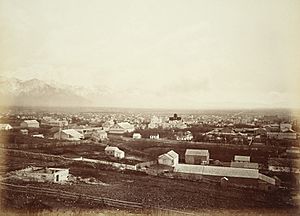
Just four days after arriving, Brigham Young chose the spot for the Salt Lake Temple. This temple, built on what is now Temple Square, took 40 years to finish. Construction started in 1853, and the temple was dedicated in 1893. It has become a famous symbol for the city. The southeast corner of Temple Square is the starting point for all addresses in the Salt Lake Valley.
During the winter of 1847, many Shoshone people died from measles. The Shoshone helped the pioneers by teaching them to eat the bulb of the native sego lily. This plant was an important part of the Shoshone diet. The sego lily is now honored by the Sego Lily Dam, a flood-prevention project built in Sugar House Park in 2017.
The pioneers tried to create a state called State of Deseret in 1849. However, the United States Congress instead created the Utah Territory in 1850, making it much smaller. Fillmore was first named the capital, but Great Salt Lake City became the territorial capital in 1856. Its name was later shortened to Salt Lake City. The city's population grew quickly with new members of the LDS Church and people seeking gold during the Gold Rush. This made it one of the largest cities in the American Old West.
In 1860, explorer Richard Francis Burton visited Great Salt Lake City for three weeks. He wrote about the city's buildings, geography, farming, politics, and social life. He also included speeches and sermons from leaders like Brigham Young.
Disagreements with the U.S. government arose over the church's practice of polygamy. In 1857, President James Buchanan declared the area in rebellion, starting the Utah War. The U.S. Army marched through the city, finding it empty, and set up Camp Floyd nearby. Another military base, Fort Douglas, was built in 1862. The church eventually stopped new polygamous marriages in 1890, which helped Utah become a state in 1896. Salt Lake City then became the state capital.
The First Transcontinental Railroad was finished in 1869. A railroad connected to Salt Lake City in 1870, making travel much easier. This led to many different groups of people moving to the city. Chinese immigrants, who helped build the railway, created a lively Chinatown called "Plum Alley." It was home to about 1,800 Chinese people in the early 1900s. Other immigrants found jobs in the growing mining industry.
In the late 1800s and early 1900s, a large streetcar system was built in the city. The first streetcar ran in 1872. However, cars became more popular, and the last streetcar stopped running in 1945. Light rail transit returned to the city when UTA's TRAX system opened in 1999.
The city's population growth slowed down in the 1900s as people moved to the suburbs. Many nearby towns grew and became their own cities. Because of this, the population of the surrounding metropolitan area is much larger than Salt Lake City itself. City leaders have been working to improve the downtown area. The city lost some population from the 1960s to the 1980s but started growing again in the 1990s.
Salt Lake City has become more diverse in recent years. About 22% of residents are Hispanic, and the city has a large LGBT community. There's also a big Pacific Islander population, mainly from Samoa and Tonga.
Salt Lake City was chosen in 1995 to host the 2002 Winter Olympics. The games were a big success, making a profit. For the Olympics, major construction projects were started, including expanding highways and building the light rail system. The Olympic venues are still used today for sports events and training. Tourism has increased since the games. On July 24, 2024, Salt Lake City was officially chosen to host the 2034 Winter Olympics again.
In 2020, the city experienced a 5.7 magnitude earthquake and a strong windstorm. These events happened during the George Floyd protests and the global COVID-19 pandemic.
Geography of Salt Lake City
Salt Lake City covers about 110 square miles (285 km²) and sits at an average height of 4,327 feet (1,319 m) above sea level. The lowest point is near the Jordan River and the Great Salt Lake, and the highest is Grandview Peak, at 9,410 feet (2,868 m).
The city is in the northeast part of the Salt Lake Valley. It's surrounded by the Great Salt Lake to the northwest, the steep Wasatch Range to the east, and Oquirrh Mountains to the west. The mountains around the city have several narrow canyons, like City Creek and Parley's.
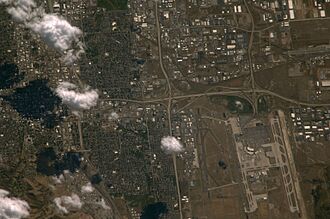
The growing population and the city's location in a valley can sometimes lead to concerns about air quality. In winter, strong temperature inversions can trap pollution, making the air quality worse. The Utah Division of Air Quality monitors the air and issues alerts. People have protested at the Utah State Capitol to ask for cleaner air.
The Great Salt Lake is separated from the city by marshlands. Sometimes, bacteria in the lake cause a smell known as "lake stink." The Jordan River flows through the city, carrying water from Utah Lake into the Great Salt Lake.
The tallest mountain visible from Salt Lake City is Twin Peaks, which is 11,330 feet (3,453 m) high. The mountains around Salt Lake City are very noticeable because they rise sharply from the valley floor.
The Salt Lake Valley floor was once the bottom of a huge ancient lake called Lake Bonneville during the last ice age. You can still see the old shorelines of Lake Bonneville as terraces on the hillsides.
Earthquake Faults
Salt Lake City is located near active fault lines that can cause earthquakes. These faults are part of the larger Wasatch Fault, which runs north–south along the base of the Wasatch Mountains. This fault is considered at high risk for a large earthquake, up to 7.5 magnitude. If a major earthquake happens, there could be significant damage, especially from liquefaction (when soil acts like a liquid) and possible flooding from the Great Salt Lake. On March 18, 2020, a 5.7 magnitude earthquake hit Magna, southwest of Salt Lake City, causing some minor damage.
In 2021, scientists found that two smaller faults, the Warm Springs Fault and the East Bench Fault, connect underneath Salt Lake City. This discovery increases the risk of major damage to the city from an earthquake.
City Layout
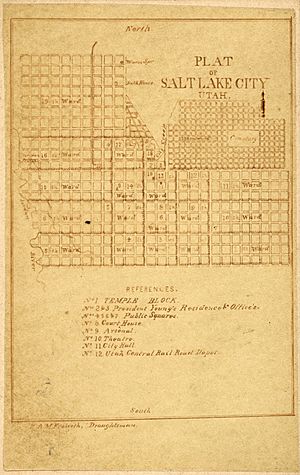
The city, and much of Salt Lake County, is set up in a grid plan. Most main streets run straight north–south and east–west. The center of this grid is the southeast corner of Temple Square. Main Street is the north–south line, and South Temple Street is the east–west line. Addresses are like coordinates in this system. For example, 100 East is the first street east of Main Street.
A common story says that the city's unusually wide streets were designed so a wagon with a team of oxen could turn around easily. However, the founder of the Latter Day Saint movement, Joseph Smith, planned this layout in his "Plat of Zion" with streets 132 feet (40 m) wide. This wide street design is common in other early Mormon towns.
Even though the addressing system might seem confusing at first, most people find it easy to navigate once they understand it. Some streets have names, like State Street, which is also 100 East. Other streets have honorary names, like Adam Galvez Street, but these are only on signs and can't be used for mail.
In The Avenues neighborhood, north of downtown, north–south streets are named with letters (A Street, B Street), and east–west streets are numbered.
The original city plan allowed for large garden plots, and many homes had water for irrigation from ditches. The first water came from City Creek. Over time, as the city grew, these ditches were replaced by modern water systems.
Cityscape

Downtown Salt Lake City has always been a center for business in the Intermountain West, and its buildings show this history. Main Street was the main business area in the late 1800s and early 1900s. It starts at the Salt Lake Temple and ends at the City and County Building. The Walker Center, built in 1912, was once the tallest building between Chicago and San Francisco. Other old buildings include the Kearns Building and the Joseph Smith Memorial Building. Salt Lake City also has two historic train stations, the Denver and Rio Grande Western Depot and the Union Pacific Depot.
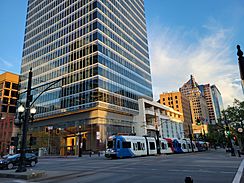
After a period of slower growth, downtown Salt Lake City is now seeing a revival, especially with the building of the TRAX system and the City Creek Center. New apartment and office buildings are being built, and the city sometimes closes Main Street to cars on summer weekends to encourage people to walk around and visit businesses. Many new restaurants and breweries have opened. Regent Street has also been updated with the Eccles Theater and a 24-story office building.
A unique feature of Salt Lake City is its very large city blocks, which are 660 feet (200 m) square. The streets are 132 feet (40 m) wide, making them some of the widest in the United States. This gives the city a unique feel but can also make it challenging for walking. However, these wide streets make it easier to add special lanes for public transport and light rail. The city is also adding protected bicycle lanes and parks.
Neighborhoods
Salt Lake City has many different neighborhoods. Generally, the eastern neighborhoods, like the Avenues, 9th & 9th, and Sugar House, tend to be wealthier. These areas are popular with professionals and families because they are close to downtown, the University of Utah, and shopping areas. The western neighborhoods, like Poplar Grove and Rose Park, tend to have more working-class families and are more diverse, with many immigrants.
This difference partly comes from the railroad being built on the west side and the better views from the higher ground on the east side. Interstate 15 also runs north–south, further dividing the east and west sides of the city.
Sugar House, in southeastern Salt Lake City, is known as an older neighborhood with small shops. It has been a focus for new development, including the UTA S-Line Streetcar.
Northeast of downtown is The Avenues, which has a different street layout with smaller blocks. This area is mostly residential and has many historic Victorian-era homes. The Avenues, along with Federal Heights and the Foothill area, are on the hillsides of the Wasatch Range. These areas have large, expensive homes and great views of the valley.
Besides these larger areas, Salt Lake City has smaller neighborhoods named after major intersections, like 9th and 9th and 15th & 15th. These areas have unique shops, art galleries, restaurants, and coffee shops that are great for walking.
Many homes in the valley were built before World War II. Only a few areas, like Federal Heights and parts of Rose Park and Glendale, have seen new home construction since the 1970s.
Climate
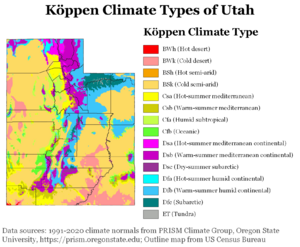
Salt Lake City has a climate with dry, hot summers and cold, wet winters. Rain is fairly steady throughout the year, except in early to mid-summer when it's minimal. The mountains around the city help keep temperatures from getting too extreme.
Most of Salt Lake City's rain and snow comes from big storms that move in from the Pacific Ocean between October and May. In late summer, rain often comes from afternoon thunderstorms. These storms are usually scattered and not severe. However, a powerful F2 tornado hit downtown on August 11, 1999, causing one death and much damage.
| Weather chart for Salt Lake City, Utah | |||||||||||||||||||||||||||||||||||||||||||||||
|---|---|---|---|---|---|---|---|---|---|---|---|---|---|---|---|---|---|---|---|---|---|---|---|---|---|---|---|---|---|---|---|---|---|---|---|---|---|---|---|---|---|---|---|---|---|---|---|
| J | F | M | A | M | J | J | A | S | O | N | D | ||||||||||||||||||||||||||||||||||||
|
1.3
37
22
|
1.3
43
25
|
1.8
54
34
|
2
62
40
|
2
72
48
|
1
83
56
|
0.6
93
65
|
0.7
91
63
|
1.2
79
53
|
1.5
65
41
|
1.5
49
31
|
1.4
38
23
|
||||||||||||||||||||||||||||||||||||
| temperatures in °F precipitation totals in inches |
|||||||||||||||||||||||||||||||||||||||||||||||
|
Metric conversion
|
|||||||||||||||||||||||||||||||||||||||||||||||
Snow typically falls from November to April, with an average of 60 inches (150 cm) per year. The nearby Great Salt Lake helps create more precipitation, especially lake-effect snow, which can bring heavy snowfall.
Temperatures in Salt Lake City vary a lot between seasons. In summer, there are about 56 days a year with temperatures of at least 90°F (32°C). Winters are cold, with about 127 days below freezing. The highest temperature ever recorded was 107°F (42°C), and the lowest was -30°F (-34°C).
During winter, strong high-pressure systems can cause temperature inversions, trapping pollutants and creating thick smog in the valley. This can lead to some of the worst air pollution levels in the country. In 2016, Salt Lake's air quality was ranked 6th worst in the nation by the American Lung Association.
Severe dry periods and water use have caused the Great Salt Lake to shrink significantly. This has exposed dry lakebed, which can release dust containing harmful chemicals like arsenic into the air, affecting people in the area.
| Climate data for Salt Lake City International Airport (1981–2010 normals, extremes 1874–present) | |||||||||||||
|---|---|---|---|---|---|---|---|---|---|---|---|---|---|
| Month | Jan | Feb | Mar | Apr | May | Jun | Jul | Aug | Sep | Oct | Nov | Dec | Year |
| Record high °F (°C) | 63 (17) |
69 (21) |
80 (27) |
89 (32) |
99 (37) |
105 (41) |
107 (42) |
106 (41) |
100 (38) |
89 (32) |
75 (24) |
69 (21) |
107 (42) |
| Mean maximum °F (°C) | 51.8 (11.0) |
58.8 (14.9) |
70.4 (21.3) |
80.2 (26.8) |
88.9 (31.6) |
97.9 (36.6) |
101.9 (38.8) |
99.6 (37.6) |
93.9 (34.4) |
82.0 (27.8) |
67.1 (19.5) |
54.3 (12.4) |
102.3 (39.1) |
| Mean daily maximum °F (°C) | 37.4 (3.0) |
43.2 (6.2) |
53.7 (12.1) |
61.6 (16.4) |
71.9 (22.2) |
83.0 (28.3) |
92.6 (33.7) |
90.5 (32.5) |
79.2 (26.2) |
64.7 (18.2) |
49.4 (9.7) |
38.0 (3.3) |
63.8 (17.7) |
| Daily mean °F (°C) | 29.5 (−1.4) |
34.2 (1.2) |
43.6 (6.4) |
50.6 (10.3) |
59.8 (15.4) |
69.7 (20.9) |
78.7 (25.9) |
77.0 (25.0) |
66.1 (18.9) |
53.0 (11.7) |
40.0 (4.4) |
30.3 (−0.9) |
52.8 (11.6) |
| Mean daily minimum °F (°C) | 21.6 (−5.8) |
25.2 (−3.8) |
33.6 (0.9) |
39.5 (4.2) |
47.8 (8.8) |
56.4 (13.6) |
64.7 (18.2) |
63.4 (17.4) |
53.0 (11.7) |
41.3 (5.2) |
30.6 (−0.8) |
22.6 (−5.2) |
41.6 (5.3) |
| Mean minimum °F (°C) | 6.5 (−14.2) |
9.2 (−12.7) |
21.0 (−6.1) |
28.7 (−1.8) |
34.8 (1.6) |
43.5 (6.4) |
54.9 (12.7) |
52.4 (11.3) |
39.7 (4.3) |
29.5 (−1.4) |
16.9 (−8.4) |
7.3 (−13.7) |
0.9 (−17.3) |
| Record low °F (°C) | −22 (−30) |
−30 (−34) |
0 (−18) |
14 (−10) |
25 (−4) |
32 (0) |
40 (4) |
37 (3) |
27 (−3) |
16 (−9) |
−14 (−26) |
−21 (−29) |
−30 (−34) |
| Average precipitation inches (mm) | 1.25 (32) |
1.25 (32) |
1.79 (45) |
1.99 (51) |
1.95 (50) |
0.98 (25) |
0.61 (15) |
0.69 (18) |
1.21 (31) |
1.52 (39) |
1.45 (37) |
1.41 (36) |
16.10 (409) |
| Average snowfall inches (cm) | 12.5 (32) |
10.7 (27) |
6.5 (17) |
4.0 (10) |
0.3 (0.76) |
0 (0) |
0 (0) |
0 (0) |
0 (0) |
1.4 (3.6) |
7.6 (19) |
13.2 (34) |
56.2 (143) |
| Average precipitation days (≥ 0.01 in) | 10.1 | 9.4 | 9.9 | 9.9 | 9.0 | 5.6 | 4.4 | 5.4 | 5.8 | 7.1 | 9.1 | 9.9 | 95.6 |
| Average snowy days (≥ 0.1 in) | 8.5 | 6.2 | 4.2 | 2.4 | 0.2 | 0 | 0 | 0 | 0 | 0.9 | 4.2 | 8.2 | 34.8 |
| Average relative humidity (%) | 74.0 | 69.8 | 60.2 | 53.2 | 48.7 | 41.4 | 35.9 | 38.5 | 45.6 | 55.7 | 66.3 | 74.3 | 55.3 |
| Mean monthly sunshine hours | 127.4 | 163.1 | 241.9 | 269.1 | 321.7 | 360.5 | 380.5 | 352.5 | 301.1 | 248.1 | 150.4 | 113.1 | 3,029.4 |
| Percent possible sunshine | 43 | 55 | 65 | 67 | 72 | 80 | 83 | 83 | 81 | 72 | 50 | 39 | 68 |
| Source: NOAA (relative humidity and sun 1961–1990), | |||||||||||||
Parks
The largest park in Salt Lake City is This Is the Place Heritage Park, which is part of the Utah State Parks system. It covers 217.5 acres (88 ha) and shows what pioneer life was like in the 1800s, with over 50 restored historical buildings. The This is the Place Monument, marking the end of the Mormon trail, is also in the park.
Sugar House Park is the second largest park at 110 acres (45 ha). It's known for its large, rolling hills and a pond. It used to host an annual Fourth of July fireworks show.
Red Butte Garden and Arboretum, located in the foothills, has many different plant exhibits and hosts musical concerts. It is run by the University of Utah.
City Parks
Salt Lake City has 85 city parks. Some of the most well-known are:
- Allen Park (8 acres/3.2 ha): developed as a bird sanctuary.
- Liberty Park (100 acres/40 ha): one of the city's oldest parks, established in 1881. It has a small lake with islands and the Tracy Aviary, home to many birds.
- City Creek Park (4 acres/1.6 ha)
- Pioneer Park (10 acres/4 ha)
- Lindsey Gardens (15.25 acres/6.2 ha)
- Gilgal Garden (3 acres/1.2 ha)
- Jordan Park (33.5 acres/13.6 ha): home to the International Peace Gardens.
- Bonneville Shoreline Trail: a popular hiking and biking trail that stretches 90 miles (140 km) through the foothills of the Wasatch Front.
Demographics
| Historical population | |||
|---|---|---|---|
| Census | Pop. | %± | |
| 1850 | 6,157 | — | |
| 1860 | 8,236 | 33.8% | |
| 1870 | 12,854 | 56.1% | |
| 1880 | 20,768 | 61.6% | |
| 1890 | 44,843 | 115.9% | |
| 1900 | 53,531 | 19.4% | |
| 1910 | 92,777 | 73.3% | |
| 1920 | 116,110 | 25.1% | |
| 1930 | 140,267 | 20.8% | |
| 1940 | 149,934 | 6.9% | |
| 1950 | 182,121 | 21.5% | |
| 1960 | 189,454 | 4.0% | |
| 1970 | 175,885 | −7.2% | |
| 1980 | 163,034 | −7.3% | |
| 1990 | 159,936 | −1.9% | |
| 2000 | 181,743 | 13.6% | |
| 2010 | 186,440 | 2.6% | |
| 2020 | 199,723 | 7.1% | |
| 2023 (est.) | 209,593 | 12.4% | |
|
Source: U.S. Decennial Census
2023 Estimate |
|||
Salt Lake City is a diverse place with people from many different backgrounds.
| Historical racial composition | 2020 | 2010 | 1990 | 1970 | 1950 |
|---|---|---|---|---|---|
| White (non-Hispanic) | 63.4% | 65.7% | 82.6% | 90.6% | n/a |
| Hispanic or Latino | 20.8% | 22.3% | 9.7% | 6.4% | n/a |
| Asian (includes Pacific Islander up to 1990) | 5.5% | 4.4% | 4.7% | 1.1% | 1.0% |
| Black or African American | 2.9% | 2.6% | 1.7% | 1.2% | 0.6% |
| Pacific Islander | 2.1% | 2.0% | n/a | n/a | n/a |
| Native American and Alaska Native | 1.4% | 1.2% | n/a | n/a | n/a |
| Two or more races | 4.2% | 3.7% | n/a | n/a | n/a |
| Race / Ethnicity (NH = Non-Hispanic) | Pop 2000 | Pop 2010 | Pop 2020 | % 2000 | % 2010 | % 2020 |
|---|---|---|---|---|---|---|
| White alone (NH) | 128,377 | 122,325 | 126,678 | 70.64% | 65.61% | 63.43% |
| Black or African American alone (NH) | 3,108 | 4,613 | 5,466 | 1.71% | 2.47% | 2.74% |
| Native American or Alaska Native alone (NH) | 1,966 | 1,624 | 1,563 | 1.08% | 0.87% | 0.78% |
| Asian alone (NH) | 6,498 | 8,151 | 10,840 | 3.58% | 4.37% | 5.43% |
| Pacific Islander alone (NH) | 3,393 | 3,706 | 4,075 | 1.87% | 1.99% | 2.04% |
| Other race alone (NH) | 294 | 444 | 1,149 | 0.16% | 0.24% | 0.58% |
| Mixed race or Multiracial (NH) | 3,853 | 3,940 | 8,448 | 2.12% | 2.11% | 4.23% |
| Hispanic or Latino (any race) | 34,254 | 41,637 | 41,504 | 18.85% | 22.33% | 20.78% |
| Total | 181,743 | 186,440 | 199,723 | 100.00% | 100.00% | 100.00% |
As of 2020, Salt Lake City had a population of 199,723 people. The city has become more diverse over the years. In 2010, about 18.5% of the people living in Salt Lake City were born in other countries. Also, 27% of households spoke a language other than English at home.
The city's population is younger than the national average. In 2000, 23.6% of the population was under 18, and the average age was 30 years old.
Less than half of Salt Lake City's residents are members of the Church of Jesus Christ of Latter-day Saints. This is a smaller percentage than in other parts of Utah. The Rose Park and Glendale areas have many Spanish-speaking residents.
Salt Lake City is also home to a large community of people from Bosnia, with over 8,000 residents. Most of them arrived in the 1990s. There's also a big Pacific Islander population, mainly Samoan and Tongan, living in the Rose Park, Glendale, and Poplar Grove neighborhoods.
Salt Lake City is known for being a welcoming place for the LGBT community. In 2015, a study ranked Salt Lake City as the 7th most "gay-friendly" metro area in the U.S.
Economy

Salt Lake City was historically known as the "Crossroads of the West" because of its railroads. In the past, industries like steel, mining, and oil refining were very important. Today, the city's economy is mostly focused on services. The main job areas are government, trade, transportation, and business services. During the day, the city's population grows to over 315,000 people, not counting tourists or students.
Local, state, and federal governments have many offices in the city, providing lots of jobs. Trade and transportation are also big employers, with Delta having a major hub at Salt Lake City International Airport. Health services and education, especially at the University of Utah, are also important job providers. Other large employers include Sinclair Oil Corporation and the Church of Jesus Christ of Latter-day Saints.
Salt Lake City is home to two large companies listed in the Fortune 1000: Zions Bancorporation and Questar Corporation. Other well-known companies based here include AlphaGraphics and Sinclair Oil Corporation. Many high-tech companies like Adobe and eBay also have a big presence in the nearby suburbs.
Tourism and conventions are also important to the economy. Tourism has grown since the 2002 Olympic Winter Games, and many new hotels and restaurants were built for the events. The convention business has also expanded with the Salt Palace convention center. Salt Lake City is even bidding to host the Winter Olympics again in 2034.
Education
In 1847, Jane Dillworth held the first classes for children in her tent. Later, there were debates about how much religion should be in schools. Today, many LDS teenagers attend religious classes called seminary in addition to their public school classes. These seminaries are often next to the public schools.
Utah spends less money per student than any other state, partly because of high birth rates and large class sizes. Many businesses donate to help schools, and some school districts have set up foundations to raise money. The Salt Lake City School District serves most of the city and has twenty-three elementary schools, five middle schools, and three high schools (Highland, East, and West). There are also private schools like Judge Memorial Catholic High School and Rowland Hall-St. Mark's School.
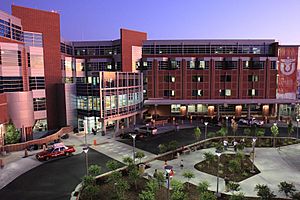
The Salt Lake City Public Library system has a main library downtown and five branch libraries. The main library, designed by famous architect Moshe Safdie, opened in 2003. In 2006, it was named "Library of the Year" by the American Library Association.
For higher education, Salt Lake City has the University of Utah, Westminster College, and Salt Lake Community College. The University of Utah is known for its research and medical programs. It was one of the first four universities connected to ARPANET, which was the beginning of the Internet, in 1969. It was also where the first artificial heart transplant happened in 1982.
Culture
Museums and the Arts
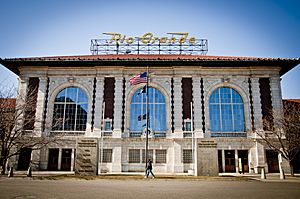
Salt Lake City has several museums. Near Temple Square is the Church History Museum, which has artifacts and art from the history of the LDS Church. At The Gateway, you can find the Clark Planetarium, which has an IMAX theater, and Discovery Gateway, a children's museum. The University of Utah campus is home to the Utah Museum of Fine Arts and the Natural History Museum of Utah. Other museums include the Utah State Historical Society and The Leonardo, a museum about art, science, and technology.
Salt Lake City also has classic movie theaters like the Tower Theatre and the Broadway Theater. The Utah Film Center offers free film screenings.
In 2007, plans were announced to create a new arts hub downtown, including renovations to theaters and a new theater with 2,400 seats.
Performing Arts
Salt Lake City offers many places for both professional and amateur theater. The historic Capitol Theatre hosts traveling Broadway shows. Local theater groups include the Pioneer Theatre Company and Salt Lake Acting Company.
Salt Lake City is home to The Tabernacle Choir at Temple Square, which started in 1847. Their weekly show, Music and the Spoken Word, is the longest-running continuous network broadcast in the world. The Utah Symphony Orchestra was founded in 1940 and performs at Abravanel Hall. In 2002, the Utah Symphony joined with Utah Opera. Salt Lake City also has famous children's choirs.
The University of Utah has highly-rated dance departments. Professional dance companies in Salt Lake City include Ballet West and Ririe-Woodbury Dance Company.
Music
The city has a lively music scene with many different styles, including hip hop, rock, and indie music. Popular groups like the Used started in this area. In the summer, Salt Lake City hosts the Twilight Concert series, which offers low-cost concerts. These concerts have been a part of the city's music scene since the late 1980s. In 2010, up to 40,000 people attended these concerts.
Festivals
Salt Lake City has many festivals throughout the year that celebrate the different cultures and interests of its communities.
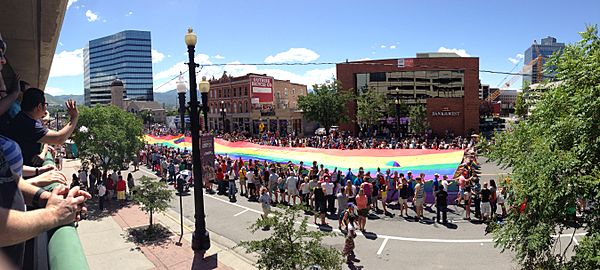
The Utah Pride Festival is an annual LGBTQ festival held in June. It started in 1983 and has grown into a three-day event with over 50,000 attendees. It's one of the largest Pride festivals in the country.
The Utah Arts Festival has been held every year since 1977, with about 80,000 visitors. It features visual artists and musicians. The Urban Arts Festival also showcases artists, music, and workshops.
The Dark Arts Festival is a three-day event for goth and industrial music fans. The Jewish Arts Festival celebrates Jewish culture with workshops, theater, food, and music. The Sugar House neighborhood also has an annual arts festival on July 4.
Salt Lake City hosts parts of the Sundance Film Festival each year. This festival brings many famous people and film lovers to see independent films. Other film festivals include FilmQuest and Salty Horror Con & Film. The Tumbleweeds film festival for kids lets families watch international films and learn about media.
The Great Salt Lake Fringe Festival, started in 2015, features various performances like music, dance, and theater. The Living Traditions Festival celebrates traditional dance, music, crafts, and food from the city's different ethnic communities.
Earth Jam is an annual festival in Liberty Park that celebrates Earth Day with music, speakers, and food. The Live Green SLC! Festival promotes sustainable products and ideas.
Craft Lake City DIY (Do-It-Yourself) festival encourages local artists to create crafts using science and technology. The 9th and 9th Street Festival is a neighborhood event celebrating art, music, and crafts.
The Catholic Nuns of Carmelite Monastery hold an annual fair each autumn. The Sri Sri Ganesh Hindu Temple of Utah has an annual Ganesh Festival. India Fest is hosted by the Krishna Temples and includes food, dances, and drama.
The local Pagan community celebrates an annual Salt Lake City Pagan Pride Day. The Steamfest festival is for fans of the steampunk style.
Rose Park hosts an annual spring festival to show off its community's diversity.
The Greek Festival, held at the downtown Greek Orthodox Church, celebrates Utah's Greek heritage with music, dance, and food. Salt Lake City also hosts Peruvian, Brazilian, Polynesian, and Japanese festivals.
Conventions
Salt Lake City hosts many conventions, using large venues like the Salt Palace and Delta Center.

Salt Lake Comic Con, which started in 2013, quickly attracted over 100,000 attendees. It even started a second event called FanX (Fan Experience). In 2014, Stan Lee called it "the greatest comic con in the world." In 2015, the Con broke a world record for the most costumed comic book characters in one place.
Crystal Mountain Pony Con is an annual My Little Pony convention. Salt Lake also hosts an International Tattoo Convention and a Gaming Convention.
Events
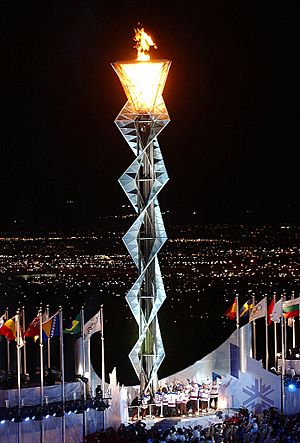
Salt Lake City has many cultural activities and events. A major state holiday is Pioneer Day on July 24, which celebrates the arrival of the Mormon pioneers. It includes parades, a rodeo, and fireworks.
First Night on New Year's Eve is a family-friendly celebration with entertainment and fireworks. Since 2004, Salt Lake City has hosted the international Salt Lake City Marathon.
Salt Lake City hosted the 2002 Winter Olympics, which brought international attention to the city. It was one of the most successful Winter Olympics ever. Salt Lake City will host the Olympics again in 2034.
The Salt Lake Gallery Stroll happens on the third Friday of every month, offering a free evening to view art in galleries.
Media
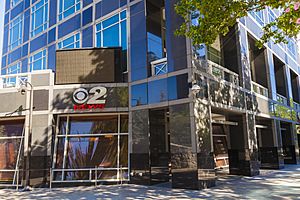
Salt Lake City has many different media outlets, including major television and radio stations. The city is a large media market in the United States.
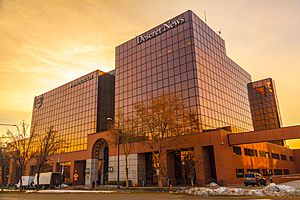
Print media includes two main daily newspapers, The Salt Lake Tribune and the Deseret News. There are also specialized publications for the Spanish-speaking community and the LGBT community. Several local magazines cover topics like arts, culture, and local issues.
Television stations include KTVX (ABC), KSL-TV (NBC), KUTV (CBS), and KSTU (Fox). Many Salt Lake radio stations can be heard throughout Utah and parts of neighboring states.
Main Sights
Salt Lake City is the main center for the LDS Church and has many related sites open to visitors. The most popular is Temple Square, which includes the Salt Lake Temple (not open to the public) and visitor centers. Temple Square also has the historic Salt Lake Tabernacle, home of The Tabernacle Choir at Temple Square. The Family History Library, the world's largest library for family history, is also nearby and open to the public for free.
In 2004, the Salt Lake City main library received an award for its unique architectural style. The building's roof offers a great view of the Salt Lake Valley. The Utah State Capitol Building has marble floors and a dome similar to the U.S. Capitol. Other notable historic buildings include the Utah Governor's Mansion and the Salt Lake City and County Building.
The Olympic Cauldron Park at Rice-Eccles Stadium features the Olympic Cauldron from the 2002 games. The Utah Olympic Park, near Park City, has the Olympic ski jumps and bobsled runs. Visitors can watch events or even ride a bobsled. The Utah Olympic Oval, in Kearns, was used for speed skating and is now open to the public.
Salt Lake City is close to several famous ski resorts like Snowbird and Park City Mountain Resort. These resorts attract millions of visitors each year and offer activities all year round.
Salt Lake City has several major shopping centers. Trolley Square is a mall with unique shops and restaurants in renovated trolley barns. The Gateway is an outdoor mall with national stores, restaurants, a movie theater, and the Clark Planetarium. City Creek Center is the newest major shopping center, with high-end stores. Sugar House is a neighborhood with a small-town shopping area and parks.
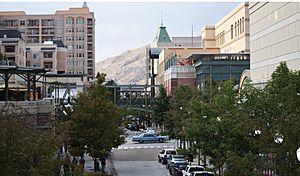
Other attractions near Salt Lake City include Hogle Zoo, Timpanogos Cave National Monument, and Lagoon Amusement Park. You can also visit the Great Salt Lake, the Bonneville Salt Flats, and the world's largest human-made excavation at Bingham Canyon Mine.
Sports and Recreation
Winter sports like skiing and snowboarding are very popular in the Wasatch Mountains east of Salt Lake City. Eight ski resorts are within 50 miles (80 km) of the city. The popularity of these resorts has grown since the 2002 Winter Olympics. In summer, people enjoy hiking, camping, rock climbing, and mountain biking in the mountains. The many reservoirs and rivers are popular for boating and fishing.
Salt Lake City has hosted two very important basketball games. The 1979 NCAA Division I Basketball Championship Game took place at the University of Utah, where Magic Johnson and Larry Bird played for the first time. Game 6 of the 1998 NBA Finals happened at the Delta Center, where Michael Jordan played his last game for the Chicago Bulls.
Professional Sports
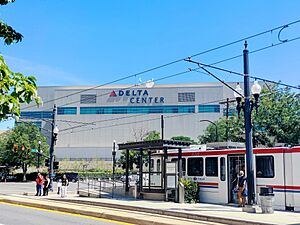
Salt Lake City is home to the Utah Jazz of the NBA, who moved from New Orleans in 1979. They play their home games at the Delta Center. The Jazz have been a successful team, making the playoffs many times with famous players like Karl Malone and John Stockton.
Real Salt Lake of Major League Soccer was founded in 2004. They first played at Rice-Eccles Stadium before moving to America First Field in nearby Sandy in 2008. The team won their first MLS championship in 2009. In 2019, the club added the Utah Royals FC, a professional women's soccer team, but it stopped operations in 2020.
Starting in the 2024–25 season, the Utah Hockey Club will play in the National Hockey League (NHL) at the Delta Center.
The Utah Warriors are a professional Major League Rugby team that started in 2018.
There are also two minor league teams in the city. The Salt Lake Bees baseball team, part of the Pacific Coast League, play at Smith's Ballpark. The Utah Grizzlies ice hockey team, part of the ECHL, play at the Maverik Center in nearby West Valley City.
| Club | Sport | League | Venue | Established | Titles | Attendance |
|---|---|---|---|---|---|---|
| Utah Jazz | Basketball | National Basketball Association | Delta Center | 1979 | 0 | 19,911 |
| Utah Hockey Club | Ice hockey | National Hockey League | Delta Center | 2024 | 0 | TBD |
| Real Salt Lake | Soccer | Major League Soccer | America First Field (in Sandy) | 2004 | 1 | 20,160 |
| Utah Warriors | Rugby | Major League Rugby | Zions Bank Stadium (in Herriman) | 2017 | 0 | 5,000 |
| Salt Lake Bees | Baseball | Pacific Coast League | Smith's Ballpark | 1994 | 0 | 15,411 |
| Utah Grizzlies | Ice hockey | ECHL | Maverik Center (in West Valley City) | 2005 | 0 | 4,622 |
| Real Monarchs | Soccer | MLS Next Pro | Zions Bank Stadium (in Herriman) | 2014 | 1 | 4,698 |
| Salt Lake City Stars | Basketball | NBA G League | Maverik Center (in West Valley City) | 2016 | 0 | 3,156 |
| Utah Archers | Field Lacrosse | Premier Lacrosse League | Zions Bank Stadium (in Herriman) | 2019 | 1 | 4,698 |
Amateur Sports
The University of Utah and Brigham Young University (BYU) have many fans in the city. The rivalry between these two colleges is very old and famous. Even though Utah is a public university, the rivalry is sometimes called the Holy War because BYU is owned by the LDS Church.
While Salt Lake City doesn't have a professional football team, the college football teams from both universities are very popular. The University of Utah was the first team from a smaller conference to win two major bowl games. BYU won the state's only college football national championship in 1984.
College basketball is also important in the city. The Utah Utes men's basketball team plays at the Jon M. Huntsman Center. They won the 1944 NCAA basketball tournament and made it to the final in 1998. The university has also hosted the NCAA Division I men's basketball tournament many times.
Transportation
Roads
Salt Lake City is where two major highways meet: I-15, which runs north–south, and I-80, which connects downtown to the airport and goes east through Parley's Canyon. I-215 forms a loop around the city.
Salt Lake City's streets are set up in a simple grid pattern. Street names are numbered with a north, south, east, or west direction, starting from Temple Square downtown. The early settlers wanted wide streets, which is why downtown streets are so spacious. This grid pattern is mostly kept throughout the city and the entire Salt Lake Valley.
Public Transportation
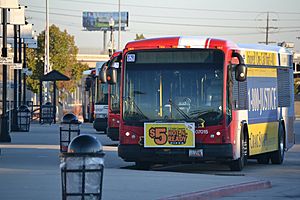
Salt Lake City's public transportation is run by the Utah Transit Authority (UTA). It includes a bus system, light rail, and a commuter rail line. All these services connect at the Salt Lake City Intermodal Hub (Salt Lake Central Station), west of the city center.
Transit Bus Service
UTA's bus system covers a large area, from Brigham City in the north to Santaquin in the south. It also has routes to the ski resorts during the ski season. About 60,000 people ride the bus every day.
Light Rail
The light rail system, called TRAX, is 44.8 miles (72.1 km) long and has three lines:
- The Blue Line goes from the Salt Lake City Intermodal Hub south to Draper.
- The Red Line runs from the University of Utah southwest through Salt Lake to Daybreak in South Jordan.
- The Green Line connects the Salt Lake City International Airport to West Valley City (through downtown Salt Lake City).
The system has 50 stations, with 23 of them inside the city. TRAX is one of the busiest light rail systems in the country.
Commuter Rail
The commuter rail system, FrontRunner, opened in 2008. It goes from the Intermodal Hub north to Pleasant View. An extension called "FrontRunner South" was completed in 2012, extending the line to Provo.
Intercity Bus and Rail Services
Amtrak, the national passenger rail system, serves Salt Lake City with its California Zephyr train, which travels between Chicago and Emeryville, California. Greyhound Lines also provides bus service to Salt Lake City. Both of these services are available at the Salt Lake City Intermodal Hub.
Air Transportation
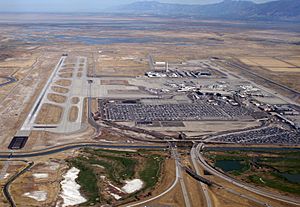
Salt Lake City International Airport is 4 miles (6.4 km) west of downtown and is entirely within the city limits. Delta Air Lines has a major hub here, with flights to over 100 destinations. The airport is served by UTA buses and a TRAX light rail line. It is one of the busiest airports in the United States and is known for being on time. The airport is currently undergoing a large renovation project.
There are also two smaller airports nearby for general aviation:
- South Valley Regional Airport in West Jordan
- Skypark Airport in Woods Cross.
Salt Lake City owns and operates the international airport and the South Valley Regional Airport.
Cycling
Salt Lake City is considered a bicycle-friendly city. In 2010, it was named a Silver-level Bicycle Friendly Community by the League of American Bicyclists. Many streets have bike lanes, and the city has a bicycle map. The city also has "Green Shared Lanes" to help cyclists.
In 2010, UTA and Salt Lake City opened a Bicycle Transit Center (BTC) at the Intermodal Hub. This center provides a safe place for cyclists to park their bikes.
In 2013, Salt Lake City launched a bike share program called GREENbike. Users can rent bicycles for a daily, weekly, or annual fee. The program started with ten stations downtown and has since expanded. The city also has the Salt Lake City Bicycle Collective.
As a result of this support, Salt Lake City's bike network has grown to 200 lane miles. In 2014, the city built a protected bicycle lane on 300 South. The city also has routes like the loop around City Creek Canyon, where parts of the road are dedicated to cyclists and pedestrians.
Utilities
Water
Salt Lake City gets most of its water from snow that melts in the Wasatch Mountains. The rest comes from underground water sources. The Salt Lake City Department of Public Utilities provides water to the city.
Energy
The main electricity provider in Salt Lake City is Rocky Mountain Power. Natural gas is provided by Dominion Energy.
Sister Cities
Salt Lake City has special relationships with these cities around the world:
- Chernivtsi, Ukraine
- Izhevsk, Russia
- Keelung, Taiwan
- Matsumoto, Japan
- Quezon City, Philippines
- Turin, Italy
Friendship Cities
Salt Lake City also has friendly relations with:
- Trujillo, Peru
See also
 In Spanish: Salt Lake City para niños
In Spanish: Salt Lake City para niños


